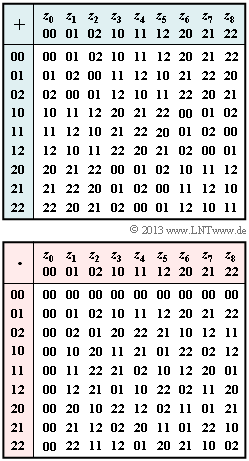Exercise 2.6: GF(P power m). Which P, which m?
A Galois field ${\rm GF}(q)$ with $q = P^m$ elements defined by the adjacent tables is to be analyzed
- for addition (marked with "$+$"), and
- for multiplication (marked with "$\hspace{0.05cm}\cdot\hspace{0.05cm}$").
This Galois field ${\rm GF}(q) = \{\hspace{0.1cm}z_0,\hspace{0.1cm} z_1,\hspace{0.05cm} \text{...} , \hspace{0.1cm}z_{q-1}\}$ satisfies all the requirements for a finite field listed in the chapter "Some Basics of Algebra" . Thus, commutative, associative and distributive laws are also satisfied.
Furthermore there is
- a neutral element with respect to addition ⇒ $N_{\rm A}$:
- $$\exists \hspace{0.15cm} z_j \in {\rm GF}(q)\text{:} \hspace{0.25cm}z_i + z_j = z_i \hspace{0.3cm} \Rightarrow \hspace{0.3cm} z_j = N_{\rm A} \hspace{0.25cm}{\rm (Nullelement)} \hspace{0.05cm},$$
- a neutral element with respect to multiplication ⇒ $N_{\rm M}$:
- $$\exists \hspace{0.15cm} z_j \in {\rm GF}(q)\text{:} \hspace{0.25cm}z_i \cdot z_j = z_i \hspace{0.3cm} \Rightarrow \hspace{0.3cm} z_j = N_{\rm M} \hspace{0.25cm}{\rm (Einselement)} \hspace{0.05cm},$$
- for all elements $z_i$ an additive inverse ⇒ ${\rm Inv_A}(z_i)$:
- $$\forall \hspace{0.15cm} z_i \in {\rm GF}(q)\hspace{0.15cm} \exists \hspace{0.15cm} {\rm Inv_A}(z_i) \in {\rm GF}(q)\text{:}$$
- $$z_i + {\rm Inv_A}(z_i) = N_{\rm A} = {\rm "0"}\hspace{0.25cm} \Rightarrow \hspace{0.25cm}{\rm kurz}\text{:}\hspace{0.15cm} {\rm Inv_A}(z_i) = - z_i \hspace{0.05cm}, $$
- for all elements $z_i$ except the zero element a multiplicative inverse ⇒ ${\rm Inv_M}(z_i)$:
- $$\forall \hspace{0.15cm} z_i \in {\rm GF}(q),\hspace{0.15cm} z_i \ne N_{\rm A} \hspace{0.15cm} \exists \hspace{0.15cm} {\rm Inv_M}(z_i) \in {\rm GF}(q)\text{:}$$
- $$z_i \cdot {\rm Inv_M}(z_i) = N_{\rm M} = {\rm "1"} \hspace{0.25cm} \Rightarrow \hspace{0.25cm}{\rm kurz}\text{:}\hspace{0.15cm} {\rm Inv_M}(z_i) = z_i^{-1} \hspace{0.05cm}. $$
Hints:
- This exercise belongs to the chapter "extension field".
- In the tables, the elements $z_0, \hspace{0.05cm} \text{...} \hspace{0.1cm} , \ z_8$ are called coefficient vectors. For example, "$2 \hspace{0.03cm}1$" stands for "$2 \cdot \alpha + 1$".
Questions
Solution
(2) Correct is the proposed solution 1:
- The neutral element of the addition $(N_{\rm A})$ satisfies for all $z_i ∈ {\rm GF}(P^m)$ the condition $z_i + N_{\rm A} = z_i$.
- From the addition table it can be read that "$0\hspace{0.03cm}0$" satisfies this condition.
(3) Correct is the proposed solution 2:
- The neutral element of the multiplication $(N_{\rm M})$ must always satisfy the condition $z_i \cdot N_{\rm M} = z_i$.
- From the multiplication table, $N_{\rm M} = \, "0\hspace{0.03cm}1"$.
- In polynomial notation, this corresponds to $k_1 = 0$ and $k_0 = 1$:
- $$k_1 \cdot \alpha + k_0 = 1 \hspace{0.05cm}.$$
(4) With the polynomial representation, the following calculations result:
- $${\rm Inv_A}("\hspace{-0.05cm}0\hspace{0.03cm}2") \hspace{-0.15cm} \ = \ \hspace{-0.15cm} {\rm Inv_A}(2) = (-2) \hspace{0.1cm}{\rm mod} \hspace{0.1cm} 3 = 1 \hspace{0.25cm}\Rightarrow \hspace{0.25cm}{\rm Vector}\hspace{0.15cm}"\hspace{-0.05cm}0\hspace{0.03cm}1"\hspace{0.05cm},$$
- $${\rm Inv_A}("\hspace{-0.05cm}1\hspace{0.03cm}1")\hspace{-0.15cm} \ = \ \hspace{-0.15cm} {\rm Inv_A}(\alpha + 1) = \big[(-\alpha) \hspace{0.1cm}{\rm mod} \hspace{0.1cm} 3\big] + \big[(-1) \hspace{0.1cm}{\rm mod} \hspace{0.1cm} 3\big] =2\alpha + 2 \hspace{0.25cm} \Rightarrow \hspace{0.25cm}{\rm Vector}\hspace{0.15cm}"\hspace{-0.05cm}2\hspace{0.03cm}2"\hspace{0.05cm},$$
- $${\rm Inv_A}("\hspace{-0.05cm}2\hspace{0.03cm}2")\hspace{-0.15cm} \ = \ \hspace{-0.15cm} {\rm Inv_A}(2\alpha + 2) = \big[(-2\alpha) \hspace{0.1cm}{\rm mod} \hspace{0.1cm} 3\big] + \big[(-2) \hspace{0.1cm}{\rm mod} \hspace{0.1cm} 3\big] =\alpha + 1 \hspace{0.25cm} \Rightarrow \hspace{0.25cm}{\rm Vector}\hspace{0.15cm}"\hspace{-0.05cm}1\hspace{0.03cm}1"\hspace{0.05cm}.$$
Consequently, only the first two proposed solutions are correct.
However, the exercise can also be solved without calculation using the addition table alone.
- For example, you can find the inverse of "$2\hspace{0.03cm}2$" by looking for the column with the entry "$0\hspace{0.03cm}0$" in the last row.
- You find the column labeled "$1\hspace{0.03cm}1$" and thus ${\rm Inv_A}("2\hspace{0.03cm}2") = \, "1\hspace{0.03cm}1"$.
(5) Multiplying $\alpha$ (vector "$1\hspace{0.03cm}0$") by itself gives $\alpha^2$.
- If the first proposed solution were valid, the condition $\alpha^2 + 2 = 0$ and thus $\alpha^2 = (-2) \, {\rm mod} \, 3 = 1$, thus yielding the vector "$0\hspace{0.03cm}1$."
- Assuming the second proposed solution, it follows from the condition $\alpha^2 + 2\alpha + 2 = 0$ in polynomial notation.
- $$\alpha^2 = [(-2\alpha) \hspace{0.1cm}{\rm mod} \hspace{0.1cm} 3] + [(-2) \hspace{0.1cm}{\rm mod} \hspace{0.1cm} 3] = \alpha + 1 $$
- and thus the coefficient vector "$1\hspace{0.03cm}1$".
In the multiplication table, in row 4, column 4, we find exactly the entry "$1\hspace{0.03cm}1$" → So, the correct one is proposed solution 2.
(6) The multiplicative inverse to "$1\hspace{0.03cm}2$" can be found in row 6 of the multiplication table as the column with the entry "$0\hspace{0.03cm}1$"
⇒ So the proposed solution 2 is correct in contrast to proposal 3. Namely, ${\rm Inv_M}("21") = \, "2\hspace{0.03cm}0"$ holds.
We check these results considering $\alpha^2 + 2\alpha + 2 = 0$ by multiplications:
- $$"1\hspace{0.03cm}2" \hspace{0.05cm}\cdot \hspace{0.05cm}"1\hspace{0.03cm}0" \hspace{0.15cm} \Rightarrow \hspace{0.15cm} (\alpha + 2) \cdot \alpha = \alpha^2 + 2\alpha = (-2\alpha-2) + 2\alpha = -2 \hspace{0.1cm}{\rm mod} \hspace{0.1cm} 3 = 1 \hspace{0.15cm} \Rightarrow \hspace{0.15cm} {\rm Vector}\hspace{0.15cm}"0\hspace{0.03cm}1" \hspace{0.15cm} \Rightarrow \hspace{0.15cm}{\rm multiplicative \hspace{0.15cm}inverse}\hspace{0.05cm}.$$
- $$"2\hspace{0.03cm}1" \hspace{0.05cm}\cdot \hspace{0.05cm}"1\hspace{0.03cm}2" "21" \hspace{0.05cm}\cdot \hspace{0.05cm} "12" \hspace{0.15cm} \Rightarrow \hspace{0.15cm} (2\alpha + 1) \cdot (\alpha + 2) = 2 \alpha^2 + \alpha + 4\alpha + 2 = 2 \alpha^2 + 5\alpha + 2 = 2 \cdot (-2\alpha - 2) + 5\alpha + 2 = (\alpha - 2) \hspace{0.1cm}{\rm mod} \hspace{0.1cm} 3 = \alpha +1 $$
- $$\hspace{2.725cm} \Rightarrow \ {\rm Vector}\hspace{0.15cm}"1\hspace{0.03cm}1" \hspace{0.15cm} \Rightarrow \hspace{0.15cm}{\rm keine \hspace{0.15cm}multiplicative \hspace{0.15cm}inverse}\hspace{0.05cm}.$$
The solution suggestion 1 is therefore not correct, because there is no multiplicative inverse for "$00$".
(7) The two expressions agree ⇒ YES, as the following calculations show:
- $$("20" + "12") \ \cdot "12" \hspace{-0.15cm} \ = \ \hspace{-0.15cm} "02"\cdot "12" \hspace{-0.15cm} \ = \ \hspace{-0.15cm} "21"\hspace{0.05cm},$$
- $$"20" \cdot "12" + "12" \cdot "12" \hspace{-0.15cm} \ = \ \hspace{-0.15cm} "02" + "22" \hspace{-0.15cm} \ = \ \hspace{-0.15cm} "21"\hspace{0.05cm}.$$
This means: The distributive law has been proved at least on a single example.
